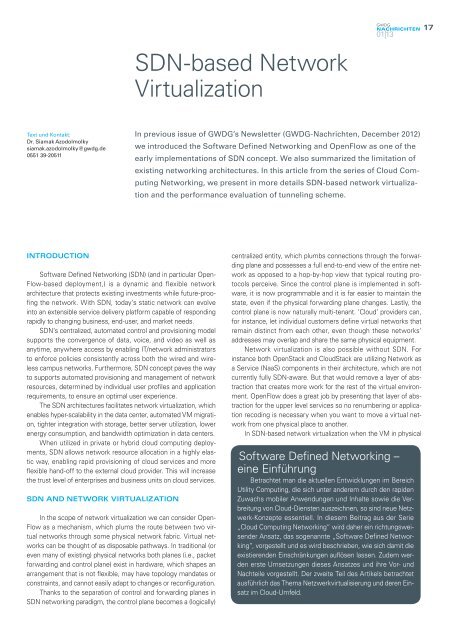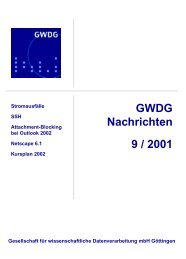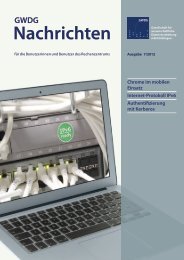GWDG-Nachrichten 1/2013
GWDG-Nachrichten 1/2013
GWDG-Nachrichten 1/2013
Erfolgreiche ePaper selbst erstellen
Machen Sie aus Ihren PDF Publikationen ein blätterbares Flipbook mit unserer einzigartigen Google optimierten e-Paper Software.
Text und Kontakt:<br />
Dr. Siamak Azodolmolky<br />
siamak.azodolmolky@gwdg.de<br />
0551 39-20511<br />
iNtroDuCtioN<br />
Software Defined Networking (SDN) (and in particular Open-<br />
Flow-based deployment,) is a dynamic and flexible network<br />
architecture that protects existing investments while future-proofing<br />
the network. With SDN, today’s static network can evolve<br />
into an extensible service delivery platform capable of responding<br />
rapidly to changing business, end-user, and market needs.<br />
SDN’s centralized, automated control and provisioning model<br />
supports the convergence of data, voice, and video as well as<br />
anytime, anywhere access by enabling IT/network administrators<br />
to enforce policies consistently across both the wired and wireless<br />
campus networks. Furthermore, SDN concept paves the way<br />
to supports automated provisioning and management of network<br />
resources, determined by individual user profiles and application<br />
requirements, to ensure an optimal user experience.<br />
The SDN architectures facilitates network virtualization, which<br />
enables hyper-scalability in the data center, automated VM migration,<br />
tighter integration with storage, better server utilization, lower<br />
energy consumption, and bandwidth optimization in data centers.<br />
When utilized in private or hybrid cloud computing deployments,<br />
SDN allows network resource allocation in a highly elastic<br />
way, enabling rapid provisioning of cloud services and more<br />
flexible hand-off to the external cloud provider. This will increase<br />
the trust level of enterprises and business units on cloud services.<br />
SDN aND NetWork VirtualizatioN<br />
In the scope of network virtualization we can consider Open-<br />
Flow as a mechanism, which plums the route between two virtual<br />
networks through some physical network fabric. Virtual networks<br />
can be thought of as disposable pathways. In traditional (or<br />
even many of existing) physical networks both planes (i.e., packet<br />
forwarding and control plane) exist in hardware, which shapes an<br />
arrangement that is not flexible, may have topology mandates or<br />
constraints, and cannot easily adapt to changes or reconfiguration.<br />
Thanks to the separation of control and forwarding planes in<br />
SDN networking paradigm, the control plane becomes a (logically)<br />
SDN-based Network<br />
Virtualization<br />
01|13<br />
In previous issue of <strong>GWDG</strong>’s Newsletter (<strong>GWDG</strong>-<strong>Nachrichten</strong>, December 2012)<br />
we introduced the Software Defined Networking and OpenFlow as one of the<br />
early implementations of SDN concept. We also summarized the limitation of<br />
existing networking architectures. In this article from the series of Cloud Computing<br />
Networking, we present in more details SDN-based network virtualization<br />
and the performance evaluation of tunneling scheme.<br />
centralized entity, which plumbs connections through the forwarding<br />
plane and possesses a full end-to-end view of the entire network<br />
as opposed to a hop-by-hop view that typical routing protocols<br />
perceive. Since the control plane is implemented in software,<br />
it is now programmable and it is far easier to maintain the<br />
state, even if the physical forwarding plane changes. Lastly, the<br />
control plane is now naturally multi-tenant. ‘Cloud’ providers can,<br />
for instance, let individual customers define virtual networks that<br />
remain distinct from each other, even though these networks‘<br />
addresses may overlap and share the same physical equipment.<br />
Network virtualization is also possible without SDN. For<br />
instance both OpenStack and CloudStack are utilizing Network as<br />
a Service (NaaS) components in their architecture, which are not<br />
currently fully SDN-aware. But that would remove a layer of abstraction<br />
that creates more work for the rest of the virtual environment.<br />
OpenFlow does a great job by presenting that layer of abstraction<br />
for the upper level services so no renumbering or application<br />
recoding is necessary when you want to move a virtual network<br />
from one physical place to another.<br />
In SDN-based network virtualization when the VM in physical<br />
Software Defined Networking –<br />
eine Einführung<br />
Betrachtet man die aktuellen Entwicklungen im Bereich<br />
Utility Computing, die sich unter anderem durch den rapiden<br />
Zuwachs mobiler Anwendungen und Inhalte sowie die Verbreitung<br />
von Cloud-Diensten auszeichnen, so sind neue Netzwerk-Konzepte<br />
essentiell. In diesem Beitrag aus der Serie<br />
„Cloud Computing Networking“ wird daher ein richtungsweisender<br />
Ansatz, das sogenannte „Software Defined Networking“,<br />
vorgestellt und es wird beschrieben, wie sich damit die<br />
existierenden Einschränkungen auflösen lassen. Zudem werden<br />
erste Umsetzungen dieses Ansatzes und ihre Vor- und<br />
Nachteile vorgestellt. Der zweite Teil des Artikels betrachtet<br />
ausführlich das Thema Netzwerkvirtualisierung und deren Einsatz<br />
im Cloud-Umfeld.<br />
17
















